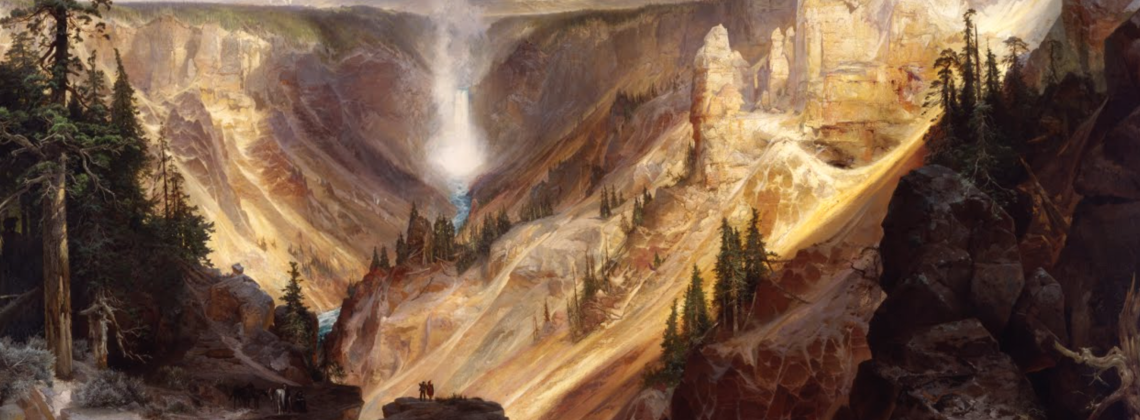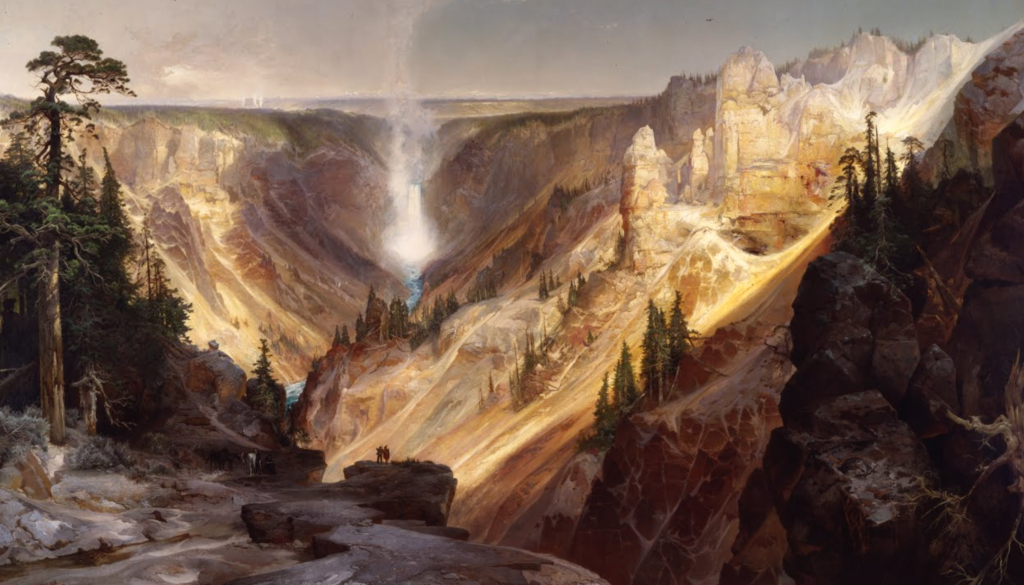

Can we still enjoy vacation destinations when we know their fraught histories?
Last month my family visited Yellowstone National Park for the first time. It was truly spectacular. We saw ginger and vermillion rock formations crusted with white travertine, crystal-clear aqua pools surrounded by rose-colored earth, rainbow-hued steam floating above an enormous hot spring, and thundering waterfalls crashing into a cream and blush canyon. Yet while the sites were stunning and otherworldly, they were neither unexpected nor unadulterated.
You see, in addition to my hiking backpack, I arrived at Yellowstone carrying all the mental baggage of an academic who has studied nineteenth-century American landscape painting and visual culture.
My visual archive—my mental folder of images of the “American landscape”—is stuffed with paintings like Thomas Moran’s 1872 Grand Canyon of the Yellowstone. Now in the collection of the U.S. Department of the Interior, the monumentally scaled canvas—more than six feet by twelve feet—fills our field of vision. Moran uses value and texture to create emphasis, calling our attention to the sun-drenched, multi-hued rocks. Meanwhile the repeated V-shape of the plunging cliffs evokes a rhythmic retreat into breathtakingly deep space. Two small figures on the promontory reinforce the landscape’s vast scale. A Native American in ceremonial dress faces towards us, as if exiting the canyon, while a survey scientist gestures enthusiastically towards the distant waterfall. Even if you haven’t seen this particular painting before, you’ve probably seen something like it: a glimmering panoramic vista organized on an imagined three-by-three grid with tiny people or animals in the foreground to contrast the towering, craggy peaks in the distance. Moran and his contemporaries, especially Albert Bierstadt and Frederic Edwin Church, refined this visual template of the sublime landscape for their nineteenth-century American audience.
Moran was still a young painter who had just learned to ride a horse when he attached himself to Ferdinand Hayden’s 1871 government-sponsored geological survey of Montana and Idaho. He joined a team of over eighty scientists, engineers, cartographers, and support staff, as well as the photographer William Henry Jackson. Jackson and Moran worked closely together; Moran assisted Jackson with his photographic compositions, and the view through Jackson’s camera helped Moran craft his own sketches. His journal entries from the expedition evidence his delight and wonder as he explored the volcanic terrain.
After sketching his way through Yellowstone, Moran returned east and produced large, finished canvases, including Grand Canyon of the Yellowstone, which was promptly purchased by Congress. Moran’s paintings were also reproduced as lithographs, allowing middle-class Americans to own a piece of this otherworldly landscape even if they couldn’t make it out West themselves.
Moran’s paintings and Jackson’s photographs are frequently credited with convincing Congress to act quickly to preserve these natural wonders and to establish Yellowstone as the first National Park. They change the public’s perception of the region: What used to be known as “Colter’s Hell” is now billed as “Wonderland.” And it’s these images that persist in our national imagination as the primary representative of, per Kenneth Burns quoting Wallace Stegner, “America’s best idea.”
But there are tensions, too. Moran paints vegetation, geological formations, and atmospheric effects with a degree of naturalistic detail that asserts documentary authority. Yet, like most other American landscape painters of the West, Moran’s canvases consist of multiple scenes integrated into an evocative singular view. When I visited Artist’s Point I saw something akin to a Moran painting, but no matter where I stood or how I angled my own viewfinder, I could not frame his Grand Canyon of the Yellowstone. Moran actually acknowledged the composite nature of his paintings. “While I desired to tell truly of Nature,” he wrote in 1889, “I did not wish to realize the scene literally, but to preserve and to convey its true impression.” Whether the public recognized—or even cared—about his artistic liberties, Moran saw his idealization as more truthful, not less.
Another friction exists between the Edenic, virgin wilderness that Moran’s paintings announce and the technologically enabled tourism they inspired. The expansion of railroads and, later, the popularity of automobiles made the previously far-flung park increasingly accessible. In 1895, 5,438 people visited Yellowstone. In 1915 when the park opened to cars, that number climbed to 51,895. The industrial revolution that many sought to escape was what made their access to the wilderness possible.
Furthermore, as Yellowstone grew in popularity as a tourist destination, indigenous access was increasingly restricted. As archaeologists have demonstrated, the area that is now Yellowstone Park was hardly untouched to begin with. Indigenous people migrated through the basin for thousands of years, and evidence of their mining, forestry, and hunting is plentiful. The Fort Laramie treaties of 1851 and 1868 actually acknowledged use rights for multiple indigenous groups in the region, even as the reservation system was being implemented. By the time of the Hayden Expedition only one band of Mountain Shoshone—the Tukudika or Sheep Eaters—were the primary native inhabitants, and their numbers were already decimated by the ripple effect of European-American exploration and expansion.
The two figures in Moran’s painting suggest the peaceful, mutually agreed-upon transfer of stewardship from indigenous people to the nation-state. The Native American in the foreground seems to be leaving the pristine wilderness to the care of the survey scientist. While not as overt as John Gast’s popular painting and print American Progress, also from 1872, Moran’s depiction likewise assumes the trope of the Vanishing Indian. This popular nineteenth-century belief held that Native Americans—too primitive and pure to engage with modernity—would naturally disappear, riding off into the proverbial sunset of the West. Even if it was not his intent, Moran’s paintings helped form a social imaginary that could gloss over physically and culturally violent efforts to erase indigenous people.
Moran’s Grand Canyon of the Yellowstone thus contains not only visual tension—between light and shadow, foreground and background—but conceptual and historical paradoxes as well. It is a detailed accounting of an imagined view. It is both an artist’s love letter to a breathtaking landscape and the impetus for 4.5 million of us to flock to a promised wilderness. It is a product and a harbinger of U.S. imperialism. It is at once truthfully evocative and dangerously silent.
When I first learned this history in graduate school I mentally surrendered any hopes of visiting, much less enjoying, national parks in the western U.S. It seemed impossible that I could take all this historical knowledge with me and still find pleasure in these fraught spaces.
Now, however, I believe that the opposite may be true.
A natural part of a human relationship is learning to navigate inherent tensions. Indeed, our most intimate bonds involve knowing another person’s flaws and strengths, bearing witness to their dark days and their personal triumphs. A robust love embraces texture and nuance. We acknowledge how another’s past has shaped them while expanding to accommodate new, sometimes unexpected, growth.
In the same way, knowing the paradoxes of a place can deepen and strengthen our relationship to it. I neither ignored nor reduced Yellowstone to a portion of its history. And I found, with gratitude, that contradiction is not the unequivocal enemy of enchantment. Perhaps this is one of our greatest gifts as humans if we can remember to use it. Complexity need not destroy delight.

Elissa Yukiko Weichbrodt is Associate Professor of Art and Art History at Covenant College in Lookout Mountain, Georgia, and she is the author of Redeeming Vision: A Christian Guide to Looking at and Learning from Art (Baker Academic, 2023). She is a Contributing Editor for Current.
This beautiful piece is noble and worthy. I recorded the last two paragraphs in my journal and savor these thoughtful phrases: “bearing witness,” “a robust love,” and “contradiction is not the unequivocal enemy of enchantment.” Love!